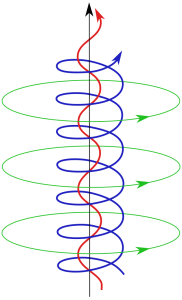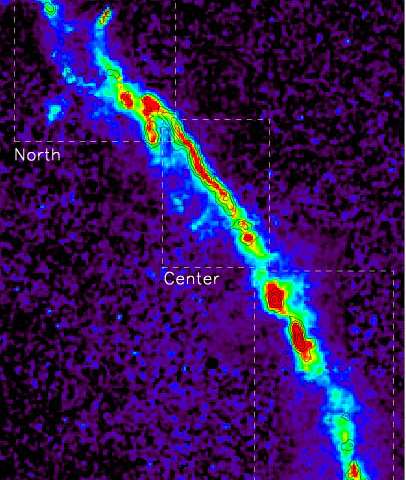http://www.astro.cornell.edu/academics/courses/astro201/bodes_law.htm
http://www.orbitsimulator.com/gravity/articles/kozai.html
http://ham.space.umn.edu/barbara/alfven.htm



http://users.monash.edu.au/~dprice/pubs/kozai/kozai.pdf
http://phys.columbia.edu/~nicolis/Div_and_Curl_of_B.pdf

Our Spot in the Wiring Diagram of the Galactic Distribution Network
Jim Weninger is a physicist with working experience in observational astronomy. During the EU2016 Conference in Phoenix he gave a break-room presentation covering some of the strongest evidence lending support to the hypothesis that the Solar System is travelling along a large scale plasma filament that closely follows the physics of the Lundquist-Scott model of Birkeland Currents.
His argument includes:
- The otherwise unexplained Titius-Bode Law mechanism provided by Don Scott which requires that the solar system is strung in such a filament.
- A unified Kozai Mechanism for both planets and satellites (both natural and manmade) based on the Lorentz force inside a larger-scale filament. The conventional explanations are ad hoc and non-unified (i.e. different explanations for different systems).
- The conventionally surprising discovery that the dipole of the “Cosmic” Microwave Background is aligned with the solar system (as demanded by the filament hypothesis).
- The conventionally surprising finding that the blue-shifted side of the dipole matches the north ecliptic pole (as demanded by the filament hypothesis).
- The conventionally surprising discovery that the background magnetic field direction in the solar neighbourhood in which the solar system travels also very closely matches the axis of the CMB dipole (Birkeland Currents are also called “field-aligned currents”, and this observation seems to be a wonderful example of such an alignment).
- The evidence of proper motion of several stars in the solar neighborhood consistent with such a hypothesis.
- The evidence of the curious lack of precession of the Sirius System with respect to Earth (from which the measurements were done) is explained if Sirius is strung in the same large-scale filament than the Solar System.
- Those observations refer to just one filament, but what Jim claims to have actually mapped is a fractal pattern of filaments embedded within filaments, further confirming Alfvén’s bold prediction of a filamentary Universe decades ago.
Adding to what the Herschel Telescope has found at the IR wavelengths throughout our galaxy, Jim has mapped the local spiral arm of The Milky Way (a huge filament as conceived from our human scale), which gives rise to a smaller scale filament that astronomers call “The Local Chimney”, in which sits the still smaller scale filament of our “Local Interstellar Cloud”, along the plasma sheath surface of which spirals the still smaller Solar System filament (the one just discussed in the bullet points above), and finally the even smaller scale filaments that flow to our sun and show up in places such as sunspots.
During his presentation, Jim commented on many seemingly disjointed observations gathered by the mainstream that make perfect sense as part of this filamentary fractal structure. Here is a list of the most salient points:
The Local “Chimney”:
- The “chimney” has an hourglass shape, with plasma inside surrounded by a dense wall of neutral material.
- A stream of stars is travelling along the axis of the chimney, and a ring of hot blue stars rotating around the “pinch”.
- A cluster of blue stars right in the middle of the pinch (right where all the current should be coming together).
- The bending of light by the dense plasma there, showing up in parallax measurements of the still unresolved “Pleiades Distance Problem”.
- The chimney axis itself is aligned consistently with what we would expect from a helical stream spiraling around a galactic arm.
The Local Interstellar “Cloud”:
- A filamentary “cloud” showing Marklund convection (or an ionization gradient with depth into the cloud).
- Radio scintillation screens (where the electrons are) mapped to the “bulk flow of the clouds”.
- The sun having a motion relative to this flow (that would be the current flow).
- The magnetic field is “parallel to the cloud surface”, meaning no radial component of the magnetic field (as expected by the Lundquist-Scott model).
- The sun is “skimming the cloud surface”, again consistent with the flow of a charged object in a filament.
- Finally, the local clouds appear to be embedded in shells of those larger scale “bubbles”. Again, if we have large scale filaments with “shells” of charged material, we get smaller scale filaments forming within the “shells”.
Also and most importantly, Jim stressed a most significant consequence of the Lundquist-Scott model that finally explains one of the main criticisms that mainstream astronomers have against Plasma Cosmology & the Electric Universe:
“If all these monstrous currents are indeed out there, where are all the required equally monstrous azimuthal magnetic fields? Wherever we look, Faraday rotation measurements always demonstrate that such magnetic fields are not there. No significant azimuthal component of magnetic fields around a filamentary structure, no currents.” Q.E.D., gravity wins.
For example, in a patently obvious electromagnetic filament like the Double Helix Nebula, if astronomers had measured a magnetic field which wrapped around it in one azimuthal direction, maybe it would have been much harder for them to ignore its electrical nature. But that’s not how electric currents in a minimum energy configuration behave in a plasma.
As the Lundquist-Scott model demands, a Birkeland Current has a tight radial structure of alternate winding and unwinding magnetic fields. If you visualize for a moment how the magnetic field vectors continually rotate with increasing radial distance, you will realize that, no matter the angle from which you observe the filament, the azimuthal component of the magnetic field always gets almost completely cancelled out, leaving only the background magnetic field in which the filament flows. A magnetic conspiracy indeed.
Conclusion:
With a Self-Similar Filamentary Universe as a main core prediction of both Plasma Cosmology and the Electric Universe, all this seems to make quite a bit of sense. Considering that the Electric Universe proposes that the sun is somewhat like a discharge lamp “plugged” to an inter-stellar power transmission line, and considering that the Herschel Telescope seems to have obtained a general view of the “galactic electric distribution network”, then Jim may have just found our “wiring” to such network, including the long-distance power transmission lines, some substations and the local power lines. All this suggests that it may be wise to start exploring a new branch of astrophysics, a subject that we may call Cosmic Circuit Theory.
Cosmic Circuit Theory
